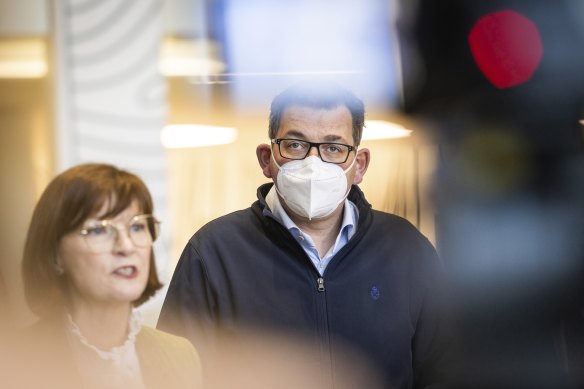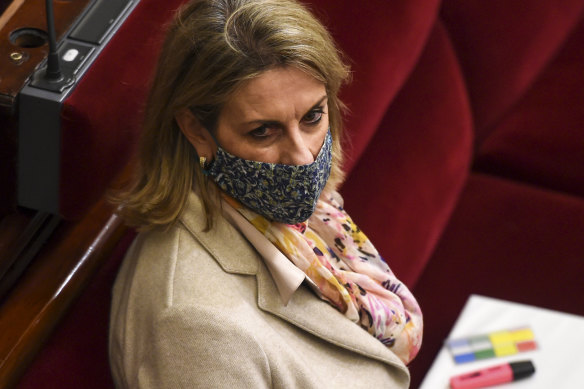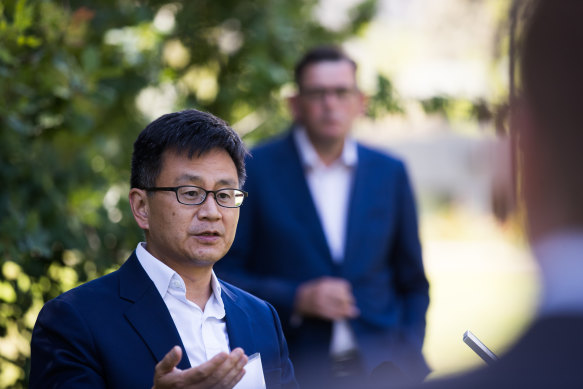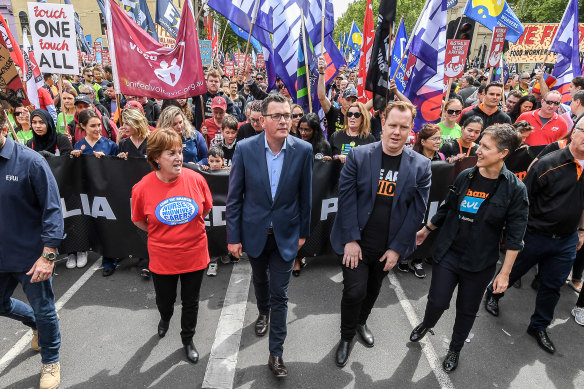- Exclusive
- Politics
- Victoria
- Coronavirus pandemic
This was published 2 years ago
Mandatory testing to end along with forced COVID-19 isolation
By Clay Lucas and Sumeyya Ilanbey
Victorians will no longer be required to report a positive COVID-19 test to health authorities as a result of changes made by the Andrews government to pandemic laws.
Since January, when the Omicron variant of the virus washed over the state, Victorians have been legally required to record a positive rapid antigen test result via an online form.

Premier Daniel Andrews and Health Minister Mary-Anne Thomas at the Monash Children’s Hospital in Clayton this week.Credit: Paul Jeffers
From Thursday, this requirement will be dropped, along with no longer having to isolate after testing positive. A state government spokeswoman said that while these legal requirements would go, the government would still encourage Victorians to let authorities know if they catch COVID.
“We still strongly recommend people isolate if they test positive and record their positive results on the website.” the spokeswoman told The Age.
Coronavirus case numbers will still be tracked but only in the background, in a similar way to the monitoring of flu cases, via sentinel testing of healthcare workers, and via GPs passing test results to the Health Department of patients who test positive.
In Britain, where isolation rules were scrapped in February, reporting RAT results remains mandatory.
The state’s pandemic declaration ends at 11.59pm on Wednesday, 940 days after a state of emergency was put in place by Premier Daniel Andrews in March 2020.
Workplace experts believe that the trend of working from home will continue, despite the formal end to pandemic regulations and the removal of any bar to workers returning to the office for five days each week.
“I think for the foreseeable future working from home is with us,” said Tim Piper, the Victorian head of business lobbyists the Ai Group.
“Companies are taking long-term positions in relation to work from home,” he said, with many locking in long leases based on the lower levels of office-based work.
The end of pandemic rules comes despite an average of six Victorians still dying each day with coronavirus. Last week, among 9230 new cases, there were 43 coronavirus-related deaths.
But serious cases have fallen dramatically. By Friday 137 patients were in Victorian hospitals with coronavirus, down from a peak of 906 in July.
Deakin University chair of epidemiology Catherine Bennett said the reporting of positive results by Victorians had been dropping off. She said that while the removal of laws requiring results to be registered would see this decline further, many would still record their positive case.
“I don’t think people are reporting because it’s mandatory,” Bennett said. Some would continue to record positive tests as a requirement of their job, or because they were in a class of healthcare worker still required to do so in order to receive financial aid.
Announcing the changes to the pandemic laws on Friday, Andrews said the new framework would “give people the choice to do what is right for them and their community”.

Opposition health spokeswoman Georgie Crozier highlighted the government’s failings.Credit: Penny Stephens
But opposition health spokeswoman Georgie Crozier said many of the decisions made by the premier and his ministers had detrimental impacts on Victorians.
“Victoria had the harshest of restrictions with the worst outcomes,” Crozier said on Saturday, promising a royal commission into the COVID response if the Coalition was elected at next month’s state election.
While the official declaration of the pandemic ends on Wednesday, vaccine mandates remain in place for health workers and aged care.
A range of experts said it was crucial that Victoria did not forget key lessons from the pandemic once the formal declaration ended.
Professor Allen Cheng, director of infection prevention and healthcare epidemiology at Alfred Health and a former deputy chief health officer, said one of the most important lessons was the way in which the pandemic had shown governments it was possible to address systemic disadvantage and health inequity.
He said by the time he left Victoria’s Department of Health in 2021, the gap in vaccination rates between the rich and poor was 6 per cent – compared with 30 per cent in NSW.
“That was a very deliberate policy of government saying this is a thing we want to fix and make sure there is equity,” Cheng said.
“That was largely successful in Victoria. We always talk about social determinants of health and people getting left behind – that [vaccination drive in 2021] shows you can fix it and there are policies that can fix it.”

Former deputy chief health officer Allen Cheng.Credit: Jason South
Of 1500 Victorians to die with coronavirus over the past three months, 50.3 per cent had not received a third vaccine dose, while 308 of those who died had received three doses.
Despite the upcoming dropping of mandatory isolation and testing laws, working from home for many is likely to continue.
Kamal Farouque, principal lawyer at Maurice Blackburn and an employment and workplace law expert, said employees had no express right to continue working from home other than via agreements with their employer over flexible working arrangements. However, he said that over the course of the pandemic working from home had suited many white-collar employees.
“And so those [employers] who don’t offer the choice of working from home, with the tight job market, will find themselves losing staff and will be less attractive as a place to go for employment.”
Farouque said it was now an expectation in many workplaces that working from home would be allowed at least some of the time. “There is no going back because the practicality of working from home and people’s expectations that it will be offered is now entrenched,” he said.
The pandemic had opened up much-needed conversations about job insecurity, and the critical work of low-paid workers, Victorian Trades Hall Council secretary Luke Hilakari said. “It also showed the importance of programs like JobKeeper and that employer groups and unions can work together to make change.”
“The pandemic was a profound moment for Australian workplaces,” he said.
Australian Nursing and Midwifery Federation state secretary Lisa Fitzpatrick said one crucial lesson from the pandemic was the low level of coronavirus deaths in public sector aged care in Victoria.

Lisa Fitzpatrick from the ANMF, Premier Daniel Andrews, Luke Hilakari from Trades Hall and ACTU secretary Sally McManus march together in Melbourne in 2018.Credit: Justin McManus
Just 3 per cent of coronavirus aged care deaths in Victoria occurred in public homes. Of 2523 deaths recorded in Victorian aged care by last month, 97 per cent were in private and not-for-profit homes. Victoria’s 179 public aged care homes have strict ratios of nursing staff to residents.
“The higher number of nurses and staff employed to care for people living in public aged care facilities was a protective factor,” Fitzpatrick said. “Having more nurses employed in private aged care will significantly reduce the pressure on our ambulances and public hospital emergency departments and beds.”
Health Workers Union secretary Diana Asmar said the pandemic had shown the value of all health sector employees, not just doctors and nurses. She pointed to the work of pathology collectors, food and kitchen staff and disability and aged care workers, among others, as crucial to the battle against COVID-19.
Many were “grossly underpaid”, she said, but the community had now learnt their worth. She said health worker shortages would continue until wages were lifted.
“Take aged care workers, who face chronic understaffing at the best of times, gasping through a mask all day for $24 an hour,” she said.
The Morning Edition newsletter is our guide to the day’s most important and interesting stories, analysis and insights. Sign up here.